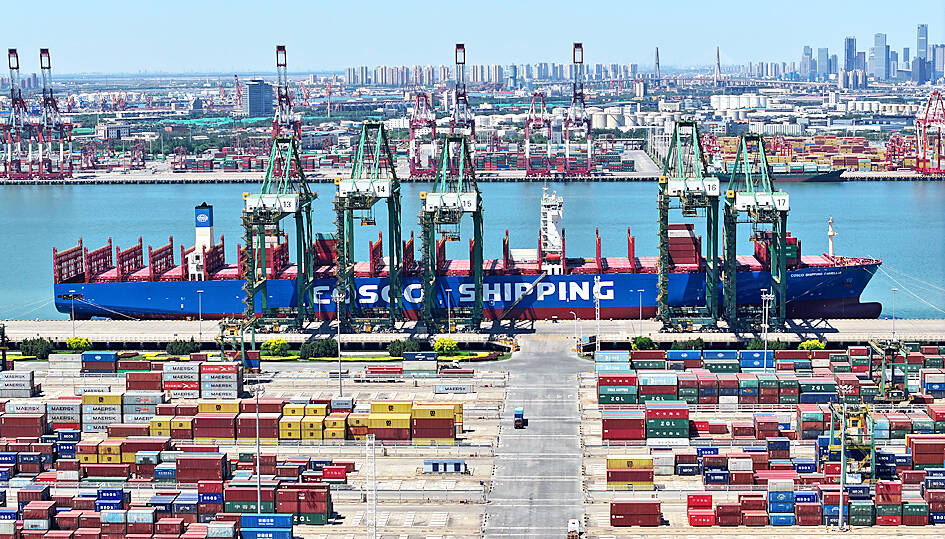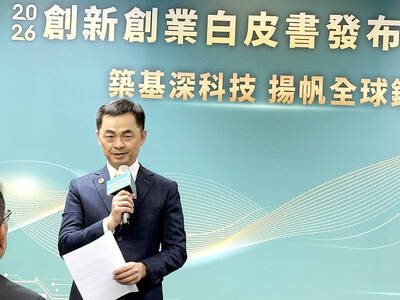Some of the steep US tariff increases on an array of Chinese imports, including electric vehicles (EVs) and their batteries, computer chips and medical products, would take effect on Aug. 1, the US Trade Representative’s office said yesterday.
US President Joe Biden would keep tariffs put in place by former US president Donald Trump while ratcheting up others, including a quadrupling of import duties on Chinese EVs to more than 100 percent and a doubling of semiconductor duties to 50 percent.
The trade agency said in a federal notice that a 30-day public comment period would close on June 28.

A container ship is berthed at the Pacific International Container Terminal of the Port of Tianjin in China on Wednesday last week.
It is seeking comments on the effects of the proposed tariff increase on the US economy, including consumers, and on whether a proposed 25 percent duty on medical masks, gloves and syringes should be higher.
The notice also provides specific tariff codes for 387 product categories affected, along with new duty rates and implementation dates.
Tariffs starting next year and in 2026 would start on Jan. 1 for those years, the trade agency said.
The proposed Chinese tariff increases include “products targeted by China for dominance, or are products in sectors where the United States has recently made significant investments,” it said.
Washington is investing hundreds of billions of dollars in clean energy tax subsidies to develop EV, solar and other new industries, and has said that China’s state-driven excess production capacity in these sectors threatens the viability of US firms.
The tariffs are meant to protect US jobs from a feared flood of cheap Chinese imports.
The new measures would affect US$18 billion in imported Chinese goods, including steel and aluminum, semiconductors, EVs, critical minerals, solar cells and cranes, the White House said.
The EV figure might have more of a political than a practical impact in the US, which imports few Chinese EVs because of prior vehicle tariffs.
The largest two categories, making up US$13.2 billion of the targeted imports from China last year, are lithium-ion batteries, US Census Bureau trade data showed.
Duties of 25 percent are due to start in 2026 on the US$10.9 billion non-vehicle lithium-ion battery category, which has grown quickly and is the third-largest US import category from China after smartphones and personal computers.
The US imported US$427 billion in goods from China last year and exported US$148 billion to the world’s No. 2 economy, a trade gap that has persisted for decades and become an ever more sensitive subject in Washington.
US Trade Representative Katherine Tai (戴琪) has said the revised tariffs were justified because China was stealing US intellectual property.
Tai has also recommended tariff exclusions for hundreds of industrial machinery import categories from China, including solar product manufacturing equipment.
China has denounced the tariff hikes and vowed “resolute measures” to protect its interests.
On Sunday, Beijing announced a new anti-dumping probe on certain industrial plastics from Taiwan, the US, Europe and Japan.
The trade agency said it would provide details on how companies could apply for machinery exclusions from the tariffs in a separate notice.
However, it said that any exclusions granted would be backdated to start yesterday and end on May 31 next year.

CHIP RACE: Three years of overbroad export controls drove foreign competitors to pursue their own AI chips, and ‘cost US taxpayers billions of dollars,’ Nvidia said China has figured out the US strategy for allowing it to buy Nvidia Corp’s H200s and is rejecting the artificial intelligence (AI) chip in favor of domestically developed semiconductors, White House AI adviser David Sacks said, citing news reports. US President Donald Trump on Monday said that he would allow shipments of Nvidia’s H200 chips to China, part of an administration effort backed by Sacks to challenge Chinese tech champions such as Huawei Technologies Co (華為) by bringing US competition to their home market. On Friday, Sacks signaled that he was uncertain about whether that approach would work. “They’re rejecting our chips,” Sacks

NATIONAL SECURITY: Intel’s testing of ACM tools despite US government control ‘highlights egregious gaps in US technology protection policies,’ a former official said Chipmaker Intel Corp has tested chipmaking tools this year from a toolmaker with deep roots in China and two overseas units that were targeted by US sanctions, according to two sources with direct knowledge of the matter. Intel, which fended off calls for its CEO’s resignation from US President Donald Trump in August over his alleged ties to China, got the tools from ACM Research Inc, a Fremont, California-based producer of chipmaking equipment. Two of ACM’s units, based in Shanghai and South Korea, were among a number of firms barred last year from receiving US technology over claims they have

BARRIERS: Gudeng’s chairman said it was unlikely that the US could replicate Taiwan’s science parks in Arizona, given its strict immigration policies and cultural differences Gudeng Precision Industrial Co (家登), which supplies wafer pods to the world’s major semiconductor firms, yesterday said it is in no rush to set up production in the US due to high costs. The company supplies its customers through a warehouse in Arizona jointly operated by TSS Holdings Ltd (德鑫控股), a joint holding of Gudeng and 17 Taiwanese firms in the semiconductor supply chain, including specialty plastic compounds producer Nytex Composites Co (耐特) and automated material handling system supplier Symtek Automation Asia Co (迅得). While the company has long been exploring the feasibility of setting up production in the US to address

OPTION: Uber said it could provide higher pay for batch trips, if incentives for batching is not removed entirely, as the latter would force it to pass on the costs to consumers Uber Technologies Inc yesterday warned that proposed restrictions on batching orders and minimum wages could prompt a NT$20 delivery fee increase in Taiwan, as lower efficiency would drive up costs. Uber CEO Dara Khosrowshahi made the remarks yesterday during his visit to Taiwan. He is on a multileg trip to the region, which includes stops in South Korea and Japan. His visit coincided the release last month of the Ministry of Labor’s draft bill on the delivery sector, which aims to safeguard delivery workers’ rights and improve their welfare. The ministry set the minimum pay for local food delivery drivers at